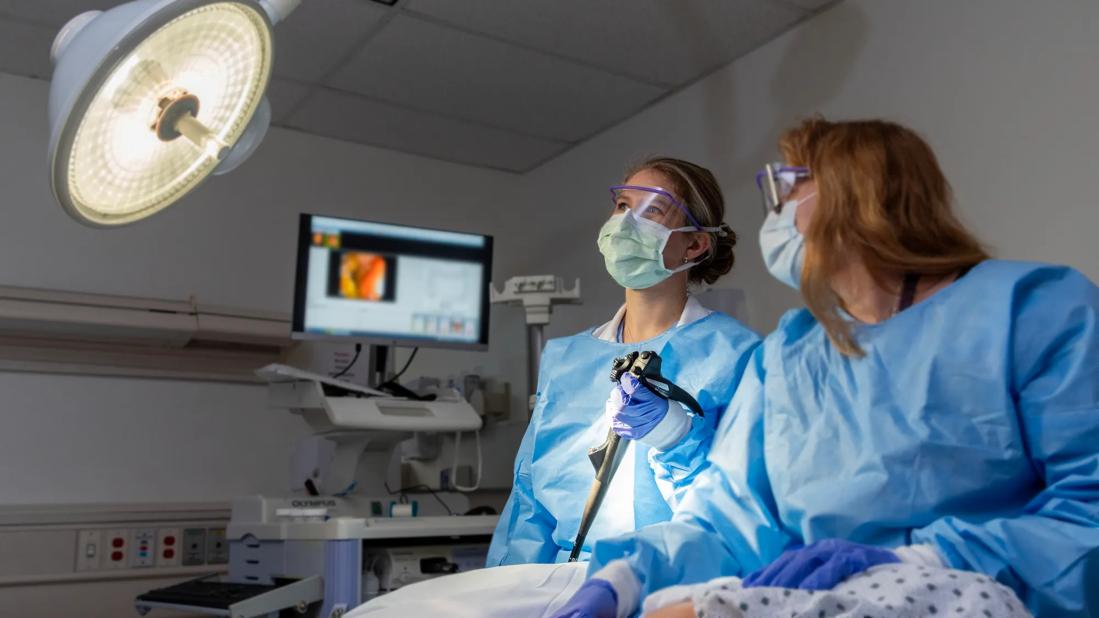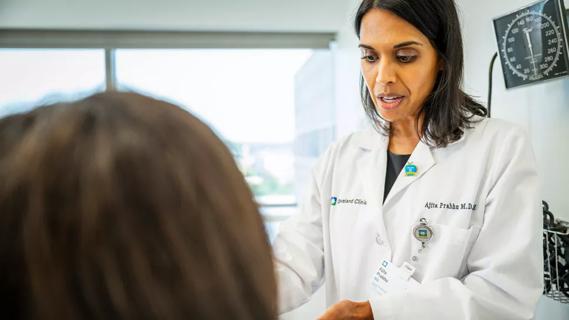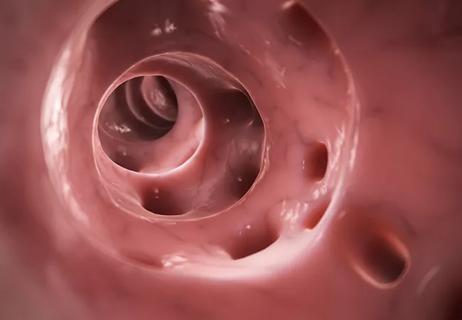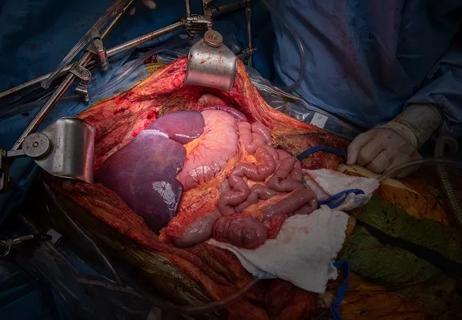Radiation to the pelvis from cancer treatment made the traditional treatment path unavailable

A patient in his 20s with familial adenomatous polyposis (FAP) was referred to Cleveland Clinic after being treated for rectal cancer. FAP is a rare hereditary condition which causes hundreds of precancerous polyps to develop in the colon and rectum and is associated with a 100% risk of becoming malignant degenerative cancer in the rectum and colon.
Advertisement
Cleveland Clinic is a non-profit academic medical center. Advertising on our site helps support our mission. We do not endorse non-Cleveland Clinic products or services. Policy
The patient had been treated for rectal cancer at an outside medical center about a year prior, and his surgeons had removed a section of his bowel and treated the cancer using radiation.
“When someone has their large intestine removed, a couple of reconstructive procedures can be done,” explains Olga Lavryk, MD, PhD, a colorectal surgeon in Cleveland Clinic’s Digestive Disease Institute. “An ileal pouch-anal anastomosis pouch (IPAA), or J-pouch, reservoir is created from the small intestine that helps patients avoid having a lifelong, permanent ostomy bag. This is something we typically lean towards with patients with FAP. However, this patient received radiation to the pelvis, so he wasn’t a candidate for that.”
The patient spoke with Scott Steele, MD, MBA, a colorectal surgeon and the President of the Cleveland Clinic Main Campus Submarket, to discuss his options. Based on his condition and patient history, the decision was made to proceed with a continent ileostomy (K-pouch) procedure.
“Normally, when surgeons see patients with FAP, it’s for preventive care since these patients are typically very healthy,” says Dr. Lavryk. “But, given the extremely high risk of cancer, eventually they will need a colectomy, and this can have a profound impact on their quality of life. Usually, patients with FAP do not have any issues with meeting the small intestine requirements for a J-pouch surgery. But, in this particular case, that wasn’t an option, and we had to figure out an alternative.”
Advertisement
Before a continent ileostomy can be created, the colon needs to be completely excised. Since FAP can lead to hundreds of colonic polyps forming, the complete excision helps prevent the polyps from developing into cancer. A reservoir is created from the small intestine to collect stool, and a continent valve allows stool to collect inside the pouch. The valve helps control stool spillage, and no outside stoma appliance is necessary to wear, unlike a traditional ostomy, where stool constantly drains into the bag. In a continent ileostomy, the pouch is emptied through intubation. Additionally, the patient can control when to empty and drain, which can significantly improve their quality of life.
“The K-pouch procedure has been around since the 1970s, but with the popularity of J-pouches, it’s not used as often anymore,” explains Dr. Lavryk. “Cleveland Clinic is one of just a handful of medical centers in the U.S. that perform this surgery specifically for patients with FAP and in cases pelvic pouch is contraindicated, since most centers will just recommend a permanent or external ostomy.”
Dr. Lavryk explains that this procedure cannot be done robotically, so for this patient, they made an incision in his abdomen and performed the colon resection. They measured the patient’s entire small intestine to ensure enough small bowel was available to construct a reservoir. They selected a segment of the intestine of about 50 centimeters, and, of that segment, 12 centimeters were used to create the nipple valve. The pouch was created by hand using three segments of the small intestine, opening the lumen and suturing the walls together. Once the pouch was created, the surgeons created and placed the ostomy in the patient’s abdomen and connected it to the pouch and reservoir tube.
Advertisement
“For patients with FAP, we also perform an upper scope of the stomach and the duodenum since patients can develop precancerous polyps in the upper gastrointestinal tract as well,” says Dr. Lavryk.
She explains that since everything is sutured by hand, the catheter is left in place for about three weeks following surgery, and afterwards the intubation is removed in the office.
“This ensures the newly created ileal reservoir remains decompressed,” says Dr. Lavryk. “During the surgery, we’ll also test the nipple valve by inflating the pouch with saline and removing the tube to ensure everything is watertight and the valve is continent.”
Following surgery, the patient has done well. The surgical team’s ostomy nurses provided the patient with training on intubation, and he’s since had one post-operative follow-up appointment.
For Dr. Lavryk, what made this case particularly challenging was the fact that the patient had already had radiation to the pelvis, which meant that he wasn’t a candidate for the more common J-pouch surgery, ultimately leading the surgical team to pursue a K-pouch approach instead.
“This patient was kind of an outlier because he had rectal cancer,” explains Dr. Lavryk. “Patients with FAP typically undergo yearly surveillance via colonoscopy from their early teenage years, and we closely monitor their number of polyps. If they develop a significant number of polyps — usually more than 100 polyps — we recommend performing a prophylactic colectomy to mitigate their cancer risk. However, this patient had already been diagnosed and treated for cancer.”
Advertisement
Dr. Lavryk also stresses that after the surgery, strong and frequent communication with patients who receive K-pouches is important. She typically recommends that patients come back for follow-up appointments every three to six months to make sure they’re progressing and advancing their diet with further annual pouchoscopy.
“Typically, there aren’t any issues, but this is a lifelong journey for these patients,” says Dr. Lavryk. “We’ll do frequent endoscopic surveillance for patients – especially those with FAP. Patients with FAP can develop polyps anywhere, and we have had patients who develop polyps in their K-pouch. Fortunately, we can typically remove these polyps endoscopically, and it doesn’t require excision or re-dos. But it’s another reason why it’s important to make sure you’re monitoring and surveilling frequently.”
Dr. Lavryk notes that although J-pouches are considered the standard-of-care treatment for most patients with FAP, each surgical option has its advantages and disadvantages. It is important to have clear and informative pre-operative discussions with patients to assist them in making the most suitable decision.
“While not performed at most institutions around the world, we have over four decades of experience with K-pouches at Cleveland Clinic,” says Dr. Steele. “These operations have been transformative for our patients, and they have contributed significantly to improving their quality of life.”
Advertisement
Advertisement

Robotic-Assisted Procedures Offer Breakthroughs in Lymphedema Treatment After Breast Cancer Surgery

Histotripsy is noninvasive and may generate abscopal effect

Treating a patient after a complicated hernia repair led to surgical complications and chronic pain

Input from specialists and other healthcare providers is important when discussing quality-of-life improvement options

Both procedures required unconventional approaches

Tumor downsizing and en bloc resection are keys to treatment

Rare complication of IPAA construction leads to discovery of a new syndrome

Seven-pound tumor requires complex, multidisciplinary care